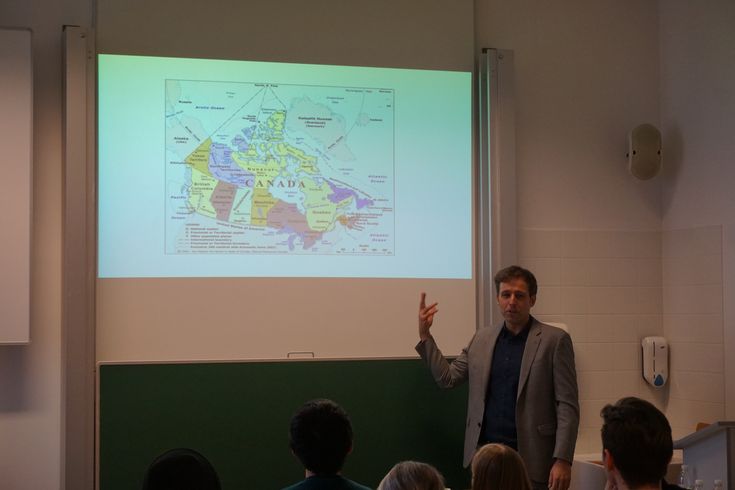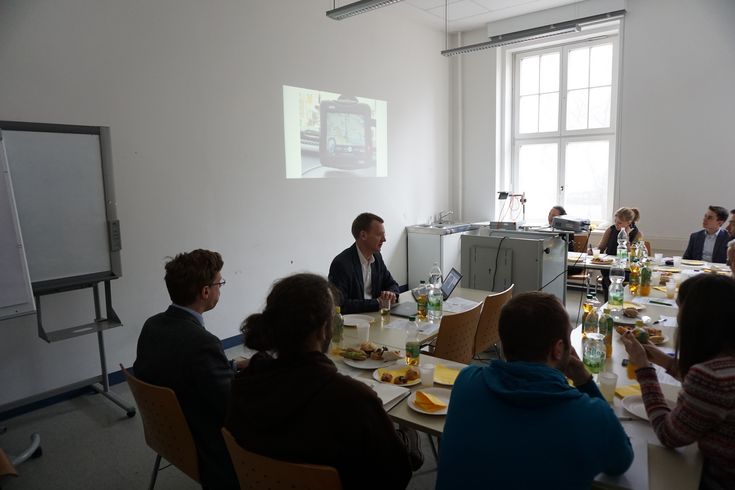The LTS continues the Winter Term 2016/17!
For the second consecutive semester Univ.-Prof. Dr. Iris Eisenberger from the Institute of Law at the University of Natural and Life Sciences organises, together with Univ.-Prof. Dr. Konrad Lachmayer from the Sigmund Freud University, the Lunch Time Series on Law, Technology and Society (LTS).
- on the 27th of October. The first lecture, "Answers to climate-induced migration under international law", was given by Prof. Dirk Hanschel (Martin- Luther-Universität Halle-Wittenberg).
- On the 17th of November 2016, Dr. William Nikolakis (University of British Columbia) gave a lecture entitled
"Advancing the social pillar of sustainability: Insights from the natural resources sector". - On the 16th of December 2016, Prof. Indra Spiecker gen. Döhmann, LL.M. (Goethe Universität Frankfurt) gave a lecture entitled "Industry 4.0 and robotics: legal challenges".
- The last lecture in this semester, "AlgorithmWatch: What's there to see?" was on the 25th of January 2017 by Matthias Spielkamp, MA MA (AlgorithmWatch.org ).
After each lecture a public discussion took place. Based on the Anglo-American model of Lunch Time Series, catering was provided.
Answers to climate-induced migration under international law

27.10.2016 Climate-induced migration presents itself as an increasing problem for the international community of states. Salinized soils, crop failures and threats of flooding to entire swathes and islands are already affecting the livelihood of millions of people. Concerned people are often forced to flee. Climate change is just one reason among other problems, like a lack of infrastructure or hardly any prospects for employment, which evoke emigration from these areas.
Meanwhile climate change has reached the courtrooms. A judgement from the Supreme Court of New Zealand has received international attention: a man from the island Kiribati left his homeland due to the rising sea levels. In New Zealand he tried to be acknowledged as the first climate refugee, but the court decided that he did not fulfill the conditions of the Convention Relating to the Status of Refugees. Therefore, he had to leave the country and return to Kiribati.
The Convention Relating to the Status of Refugees protects people, who flee due to justified fear of persecution through human or governmental actions. Is it even appropriate to talk about “climate refugees” and “climate-induced migration”? Climate change is caused by humans, but it is difficult to make single states accountable for climate change. Detached from the terms of the Convention Relating to the Status of Refugees, the designation “climate refugee” still appears rather suitable. Therefore, the term “flight” is preferable, when people leave their homeland due to rescue themselves from threats.
Currently the international law addresses “climate migration” just insufficiently. In medium and long term Hanschel sees a solution in a combination of human rights and international environmental law regulations. Especially the rights to life, food, water and health offer an individual human-rights based standard of protection. In addition, he proposes a “protocol of climate migration”, which acknowledges, protects and resettles climate refugees. Therefore, states have to provide the financial means and offer cross-border help. The rules for international law could be elaborated within the negotiations of the UN Framework Convention.
The audience questioned, if the UN climate negotiations were the right place to discuss “climate migration”. According to Hanschel the setting is rather appropriate, because it offers an established system with regular meetings. The political pressure of these meetings might bring better results.
Hartlieb/Müllner, October 2016
Advancing the social pillar of sustainability: Insights from the natural resources sector

17.11.2016 As a part of the “LunchTimeSeries on Law, Technology and Society” (LTS), Dr. William Nikolakis gave a lecture on the social pillar of sustainability from a natural resources perspective on 17 November 2016. This highly interesting, recent and interdisciplinary topic could not have fit any better into an auditorium at the University of Natural Resources and Life Sciences, Vienna.
Nikolakis was born in Australia and now lives in Vancouver (Canada) where he works as a Research Fellow at the University of British Columbia (UBC). He specializes in Sustainability Management and (amongst others) advises Aboriginal collectives, governments and corporations on policy and business issues.
In his lecture on social aspects of sustainability, Nikolakis focused on the Canadian situation: an area the size of almost ten million km², of which 90 per cent is owned by the Crown; ten provinces, each of them having the right to decide over the use of natural resources within their borders; 175 billion barrels of crude petroleum reserves; oil sand deposits almost twice the size of Austria, the mined area being larger than the city of Vienna; exports worth 231 billion dollars and 1.77 million jobs that are associated with natural resources (2015). Needless to say, natural resources in Canada are big.
But so are the challenges that come along with the cumulative impacts from these activities: There are approximately 1.84 million Indigenous People in Canada (2011) and numerous unresolved land claims. Such non-market aspects like spiritual and cultural values tend to be ignored in the decision making process. This is why the social pillar of sustainability is often perceived to be less attractive than the economic and environmental pillar.
The Indigenous Peoples of Canada – First Nations, Inuit and Metis people – had had sovereignty prior to European colonization, in the course of which they were subjects of the Crown. The application of the terra nullius (“nobody’s land”) doctrine was part of the colonial paradigm, which characterizes long phases of the relationship between Indigenous Peoples and the Natural Resources Sector represented by the Canadian Government.
Since then, Indigenous People have been granted more rights little by little, with the Calder Decision 1973, the Constitution Act 1982 and the United Nations Declaration on the Rights of Indigenous Peoples (UNDRIP) 2007 representing the most important milestones. Moreover, further steps in the right direction have been taken under the first year of the Trudeau-Administration.
The goal – a culture of communication that seeks free, prior and informed consent (FPIC) and accepts rather than bypasses objection – may be in sight, but has yet to be reached.
Thomas Buocz/Annemarie Hofer
The given presentation can be found here: William Nikolakis, Advancing the social pillar of sustainability: Insights from the natural resources sector
Industry 4.0 and robotics: legal challenges

16.12.2016 Professor Indra Spiecker gen. Döhmann, LL.M., was the speaker at the last LunchTimeSeries before the Christmas holidays. Indra Spieker gen. Döhmann is Professor of Public Law, Information Law, Environmental Law, and Legal Theory at the Goethe University of Frankfurt am Main. The talk’s title was ‘Industry 4.0 and robotics: legal challenges’. It discussed future challenges arising from industry 4.0 by using the health care system as an example.
So what exactly are industry 4.0 and robotics? At the very beginning of her talk, Prof Spiecker made clear that those two concepts are strongly intertwined. Industry 4.0 is more than the digitalisation of manufacturing sites or logistics centres. It is a keyword for automated, connected and self-learning systems.
Prof Spiecker illustrated this through technological developments in health care. There are fundamental new opportunities regarding, for example, diagnostic and surgical technology or integrated prosthetics, brain, and organ stimulation. Another area is so-called ‘tele-medicine’, which is a supply-perspective for underpopulated areas.
These various potentials also cause new problems. The ever-growing interconnection makes the need to protect computer systems from hackers nearly inevitable. Prof Spiecker emphasised this threat by using the following example: Imagine a heart surgery, undertaken by a surgical robot. During the surgery, hackers enter the robot’s system and infect it with ransomware. The robot stops operating until the ransom is anonymously paid via bitcoin. In this scenario, there will be no other option than to give in.
Industry 4.0 also diminishes personal decision-making leeway. Just think about automated vehicles, where standardised systems replace human decisions. Additionally, this scenario raises questions of liability, especially when mistakes occur.
Concluding, Prof Spiecker presented different solution approaches. To guarantee data safety, it could be useful to take a step back towards separated systems, as they have better protection from hackers. However, the advantages of interconnection would be lost. At the same time, separation brings more autonomy and control, because users would not have to face an open system. Another approach is to set democratic minimum standards. In other words, legislators should actively engage by setting norms. This has already succeeded through implementation of the EU General Data Protection Regulation. Through the concept of ‘privacy by design’, the regulation requires that data-processing infrastructure be constructed to fulfil data protection regulations from the very beginning. Through anticipatory measures like this, the European Union may take a pioneering role.
The anticipatory aspect was also a prominent topic throughout the following discussion, where the audience asked if legislation would not necessarily always lag behind technological innovation. As an answer, Prof Spiecker explained the idea behind ‘privacy by design’: the legislator tries to regulate the development-process at a very early stage. Because of this, possible conflicts with the data protection law should not even emerge. The example of ‘privacy by design’ shows that anticipatory regulation is, in fact, doable. Prof Spiecker closed her talk with the following words, aimed at legislation: ‘Time is running fast, but IT is even faster’.
Stefan Steininger
AlgorithmWatch: What’s there to see?

25.01.2017
AlgorithmWatch: What’s there to see?
Mathias Spielkamp gave the last lecture of the LunchTimeSeries in the winter term 2016/17. He talked about the potentials and risks of algorithms. Mr. Spielkamp is a journalist, editor of the online magazine “iRights.info”, and founding member of “AlgorithmWatch”, which is a non-commercial initiative founded in 2016. The aim of the project is to examine algorithms found in different areas of life. Its manifesto emphasises the rising frequency of automated decision-making processes, and it aims to bring greater transparency to algorithm-based decisions. If there is greater transparency, the underlying processes will be more easily understood by individuals.
Although many people see ‘independently thinking’ systems as a new phenomenon, such systems have been part of our lives for several decades. Take navigating systems, spam-filters or autopilots in aircraft – all of which use algorithm-based programs . Even if the use of new technologies is controversial in society, it is widely accepted in many fields. If the use of systems like these was prevented, many advantages that have already been achieved would go to waste.
Algorithm-based systems offer many opportunities: data is processed more quickly, and decisions can be reached more efficiently and probably in a more just and fair way. Security is higher, as human error can be avoided. To benefit from these advantages across society, everyone must be able to understand the underlying processes of algorithms. On the one hand, transparency brings wider acceptance. On the other hand, developers have to disclose ‘unfair’ or unjust criteria.
Decisions made by machines or programs are often assumed to be neutral. However, when a programmer is programming, he weaves his values into the algorithm. Mr. Spielkamp defines systems like autonomous border controls, systems that forecast risk concerning criminals or algorithms for regional crime forecasts as ‘potentially dangerous algorithms’. In some cases, these algorithms use personal data such as skin colour, sex or ethnic origin in their decision-making processes. These data pose a high risk of discrimination.
Algorithms are taking over many decision-making processes in our daily lives, and this is having a significant impact on society. It is therefore especially important to enable democratic participation when developing these algorithms. To facilitate this participation, algorithm-led processes should be more transparent. This particularly concerns the disclosure of underlying data.
Algorithms raise many questions and insecurities. This became clear in the discussion following the lecture. Among questions concerning data protection, the societal impact and the technical details were of great interest to the audience. According to Mr. Spielkamp, this once again showed the importance of interdisciplinary cooperation.
Paula Resch (Translation: Annemarie Hofer), January 2017

